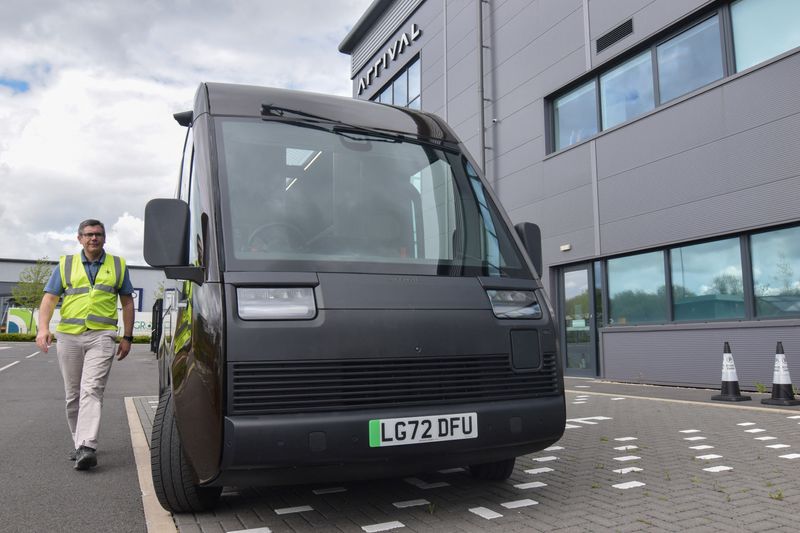British EV maker Arrival seeks second chance with US EV tax credits
2023.05.25 02:26

© Reuters. FILE PHOTO: Jules Carter, vice president of the L-Van program at electric van maker Arrival, walks next to a working prototype vehicle at the company’s factory in Bicester, Britain, May 10, 2023. REUTERS/Nick Carey
2/3
By Paul Lienert and Nick Carey
DETROIT/BICESTER, England (Reuters) – British electric van startup Arrival, which has hit many road bumps in its quest to become the next Tesla (NASDAQ:) Inc, now hopes huge subsidies from the U.S. Inflation Reduction Act and a second reverse merger will give it a fresh shot at survival.
Since it was founded in 2015, Arrival has developed vehicles for high-profile customers like United Parcel Service Inc (NYSE:) and Uber Technologies (NYSE:) Inc, but has burned through piles of cash without ever hitting mass production and is winding down its UK operations in favor of refocusing on the United States.
With the $283 million it should receive from a merger with special-purpose acquisition company (SPAC) Kensington Capital Acquisition Corp V, announced in April, executives at Arrival said they will focus on just one U.S.-produced vehicle for now. That vehicle is a larger Class 4, or medium-duty, delivery van that will bring customers a $40,000 IRA subsidy, far above the $7,500 for smaller electric vans.
Arrival’s new investors are “very excited about our U.S. product and the U.S. market,” Chief Financial Officer John Wozniak said. “There are a lot of tail winds there,” including a recent California mandate requiring commercial fleets to transition to electric over the next 10 years.
Crucially, Arrival says early investor UPS is still an anchor customer – it has ordered up to 10,000 vans – though admittedly not a happy one after waiting years for vehicles.
“We continue to evaluate Arrival’s decision to refocus its efforts in production and how this may impact potential, future vehicle deployments,” a UPS spokesperson said.
Other EV startups like Rivian Automotive Inc, Lucid Group Inc, Fisker Inc and Lordstown Motors Corp have faced similar challenges, trying to ramp up production while burning through cash at a time when few investors will give them more.
But the IRA, which took effect last August, has provided enough of a lifeline to Arrival to attract new investors. It includes customer tax credits for purchases of certain EVs.
Arrival now aims to begin producing its medium-duty XL Van at a “microfactory” in Charlotte, North Carolina, by late 2024, and Wozniak said he is confident of hitting that target.
The company has so far made three prototypes of its smaller L Van at its Bicester plant in the United Kingdom, which are being road-tested to aid development of the larger, more expensive model.
Class 4 vans are more appealing than smaller models “because the prices and margins are so much higher,” said Michael Abelson, head of Arrival’s North American unit.
“The question is, will they have enough cash to actually get into series production?” said David Bailey, a professor of business economics at the University of Birmingham.
‘ABSOLUTE LIFELINE’
At its peak, Arrival was developing two different electric vans and an electric bus. It was also developing a specially designed electric car for Uber drivers.
But like other electric startups that collectively raised billions through SPACs, Arrival found that going from concept to mass production is both expensive and immensely difficult.
The company projected 2024 revenue of $14 billion in its initial SPAC deal’s investor presentation, but Arrival lost a combined $2.3 billion in 2021-2022.
To conserve cash, Arrival has cut staff almost 75% to 750 employees. It had just $130 million in cash at the end of the first quarter in an industry where launching a single model can easily cost $1 billion.
The startup warned in November it would run out of cash before the end of 2023.
Arrival’s second SPAC is with Kensington, whose earlier deals brought startups QuantumScape, Amprius and Wallbox to the market.
The rare double SPAC is being watched by others in the industry to see if it is worth replicating.
An executive with experience running SPACs, who spoke on condition of anonymity, said Kensington’s deal was an “an absolute lifeline” for a startup in Arrival’s situation.
“There’s no way they would find that kind of money anywhere else,” the executive said. “There could be more of this if these guys are able to make it happen.”
Reuters contacted all of Arrival’s current institutional shareholders, but they either did not respond or declined to comment.
‘ROOM TO RUN’
The IRA is key to making Arrival’s turnaround work, which the University of Birmingham’s Bailey said was ironic in light of the company’s former reputation as the “great British hope.”
“It was seen as Britain’s Tesla and yet it’s the U.S. government that’s essentially supporting it,” he said.
The U.S. medium-duty Class 4 van segment is relatively small, with annual sales of 30,000 to 40,000 vehicles. That is too small for most major manufacturers, so it leaves Arrival with just a few rivals.
Those competitors include Shyft Inc, a Michigan-based manufacturer of multi-brand specialty commercial vehicles whose Blue Arc electric vans will go into production this fall.
Daimler (OTC:) Trucks’ new Rizon brand will start importing electric vans from Japanese affiliate Fuso later this year that qualify for IRA subsidies because of free trade agreements with Japan.
California-based startup Xos Inc, which sold just 31 vehicles in the first quarter, is also a competitor.
With price tags for medium-duty electric vans targeted to start from around $175,000, the segment represents a potential market worth $5 billion or more.
“We think that (Class 4) is a sweet spot where Arrival can make a lot of money,” CFO Wozniak said. “We looked across the competitive landscape, and from where you sit today, there’s a lot of room to run in that segment.”








